Archive for the ‘Chinese Clothing’ Category
The Thousand Faces of the Tang Costume
In terms of cultural and economic development of the feudal society, the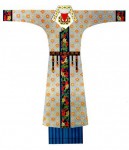 Tang Dynasty in China was doubtless a peak in the development of human civilization. The Tang government not only opened up the country to the outside world, allowing foreigners to do business and come to study, but went so far as to allowing them in exams for selection of government officials. It was tolerant, and often appreciative, of religions, art and culture from the outside world. Chang’an, the Tang capital, therefore became the center of exchange among different cultures. What is worth special mention is that women of the Tang Dynasty did not have to abide by the traditional dress code, but were allowed to expose their arms and back when they dressed, or wear dresses absorbing elements from other cultures. They could wear men’s riding garments if they liked, and enjoyed right to choose their own spouse or to divorce him. Materialistic abundance and a relatively relaxed social atmosphere gave Tang Dynasty the unprecedented opportunity to develop culturally, reaching its height in poetry, painting, music and dance. Based on the development in textiles in the Sui Dynasty, and progress made in silk reeling and dyeing techniques, the variety, quality and quantity of textile materials reached unprecedented height, and the variety of dress styles became the trend of the time.
Tang Dynasty in China was doubtless a peak in the development of human civilization. The Tang government not only opened up the country to the outside world, allowing foreigners to do business and come to study, but went so far as to allowing them in exams for selection of government officials. It was tolerant, and often appreciative, of religions, art and culture from the outside world. Chang’an, the Tang capital, therefore became the center of exchange among different cultures. What is worth special mention is that women of the Tang Dynasty did not have to abide by the traditional dress code, but were allowed to expose their arms and back when they dressed, or wear dresses absorbing elements from other cultures. They could wear men’s riding garments if they liked, and enjoyed right to choose their own spouse or to divorce him. Materialistic abundance and a relatively relaxed social atmosphere gave Tang Dynasty the unprecedented opportunity to develop culturally, reaching its height in poetry, painting, music and dance. Based on the development in textiles in the Sui Dynasty, and progress made in silk reeling and dyeing techniques, the variety, quality and quantity of textile materials reached unprecedented height, and the variety of dress styles became the trend of the time.
The most outstanding garments in this great period of prosperity were women’s dresses, complimented by elaborate hairstyles, ornaments and face makeup. The Tang women dressed in sets of garments, each set a unique image in itself. People no longer dressed by their whims, but played up the full beauty of their garment based on their social background. Each matching set of garments had its own unique character, as well as a deep cultural grounding. In general, the Tang women’s dresses can be classified into three categories: the hufu, or alien dress that came from the Silk Road, the traditional ruqun or double layered or padded short jacket that w as typical of central China, as well as the full set of male garments that broke the tradition of the Confucian formalities. Let’s first talk about the ruqun, which is made up of the top jacket and long gown and a skirt on the bottom. The Tang women inherited this traditional style and developed it further, opening up the collar as far as exposing the cleavage between the breasts. This was unheard of and unimaginable in the previous dynasties, in which women had to cover their entire body according to the Confucian classics. But the new style was soon embraced by the open-minded aristocratic women of the Tang Dynasty. Zhang Xuan, a woman painter of the Tang Dynasty, and Zhou Fang, another famous painter, were particularly good at portraying opulent women in elaborate dresses. Zhou Fang, in his painting Lady with the Flower in the Hair, portrayed a beauty with a long gown lightly covering the breasts, revealing soft and supple shoulders under a silk cape.
The chart of the make-up order for Tang Dynasty women. A facial make-up of Tang women. (Drawn by Gao Chunming)
The Elegant Wei and Jin Period
 Lady in the Wei & Jin Dynasty wearing a long robe with wide sleeves and overlapping hems. In China’s political history, the Wei and Jin Period was a period of volatility, which spanned over 200 years. Frequent changes in political power and incessant wars added to the suffering of the people, who were already devastated by natural disasters and plagues. The once dominant laws and orders collapsed. So did the once unchallenged power of Confucianism. At the meantime, the philosophy of Lao Zi and Zhuang Zi became popular; Buddhist scripture was translated; Daoism developed; and humanitarian ideology emerged among the aristocrats. The aristocratic descendants aspired individualism and led the trend in all aspects of social life. This rank of “cultural elite” was engaged in making friends, making social commentaries and controlling public opinions. Their behavior posed a threat to the conservative and the imperial power, which tried to crush them by force. It is not unfitting to say that the life threatening danger and distress was unsurpassed in the Wei and Jin Dynasties. However, another typical image of the Wei and Jin literati was on that indulgence in drinking, merry making, and talking of metaphysics. The treacherous nature of politics forced these scholars to seek comfort and relief in these aspects. Facing the hypocrisy and constraint of traditional orders, they preferred a life of truth and freedom. They sought the carefree lifestyle, the maintenance of good health or indulgence in earthly pleasures. These aristocrats changed significantly in aesthetic taste and behavior, intentionally breaking away from traditional morality in their daily life. Some dressed themselves in free and casual elegance while the rest went to both extremes, sloppy or meticulous.
Lady in the Wei & Jin Dynasty wearing a long robe with wide sleeves and overlapping hems. In China’s political history, the Wei and Jin Period was a period of volatility, which spanned over 200 years. Frequent changes in political power and incessant wars added to the suffering of the people, who were already devastated by natural disasters and plagues. The once dominant laws and orders collapsed. So did the once unchallenged power of Confucianism. At the meantime, the philosophy of Lao Zi and Zhuang Zi became popular; Buddhist scripture was translated; Daoism developed; and humanitarian ideology emerged among the aristocrats. The aristocratic descendants aspired individualism and led the trend in all aspects of social life. This rank of “cultural elite” was engaged in making friends, making social commentaries and controlling public opinions. Their behavior posed a threat to the conservative and the imperial power, which tried to crush them by force. It is not unfitting to say that the life threatening danger and distress was unsurpassed in the Wei and Jin Dynasties. However, another typical image of the Wei and Jin literati was on that indulgence in drinking, merry making, and talking of metaphysics. The treacherous nature of politics forced these scholars to seek comfort and relief in these aspects. Facing the hypocrisy and constraint of traditional orders, they preferred a life of truth and freedom. They sought the carefree lifestyle, the maintenance of good health or indulgence in earthly pleasures. These aristocrats changed significantly in aesthetic taste and behavior, intentionally breaking away from traditional morality in their daily life. Some dressed themselves in free and casual elegance while the rest went to both extremes, sloppy or meticulous.
In this period, people were divided into nine classes by their ranks in court or their property. A clear-cut line was drawn to separate these classes, who may never marry each other. Not only the rich used every opportunity of weddings and funerals to show off their wealth, but the commoners also followed suit. There was a story in Shi-shuo Hsin-yu (A New Account of Tales of the World) that a scholar Ruan Ji (210-263) and his niece Ruan Xian, lived south of the road while some better-off Ruans lived north of the road. Every year on July the 7th of the lunar calendar, the northern Ruans took out their clothing to be aired under the sun, showing off their silks and brocades. In response to this Ruan Ji took out his shoddy underwear made of coarse homespun cloth and sunned it on a bamboo pole. This behavior itself was sarcasm against the showing off and the Confucian formalities with clothes.
The “Seven Gentlemen of the Bamboo Forest” refers to the seven gentlemen of the Wei and Jin Period, including Ruan Ji and Ruan Xian. Today we can still see on wall paintings how they once dressed – the front of the garment dragging to the floor, exposing the chest, arms, shins and feet. This is a rare scene among the literati of the Chinese feudal society, because only the lower class exposed their arms and legs. Moreover, their characters were no less defiant than their clothes. In paintings, Liu Ling, Ji Kang and Wang Rong of the “seven gentlemen” had their hair done in children’s buns, cynical of all the tradition and customs of the world. As far as Chinese folk garments are concerned, the taste of the literati significantly expanded the aesthetics of ancient China. The Chinese classical sense of beauty started out as something quite simple: soft hands and supple skin, sweet smile and beautiful eyes formed the ideal beauty of the Spring and Autumn Period, praising the unpretentious and natural beauty. By the Wei and Jin Period, descriptions of female beauty moved on to include the hairstyle, the dresses and the ornaments. The more sophisticated aesthetics of the Wei and Jin Period brought about great progress in dress and ornaments. 
In the Wei and Jin Period, especially during the Eastern Jin Period (317-420), the aristocratic women went after an uninhibited life style along with the collapse of the Eastern Han feudal ethical code. These women looked down upon the role society imposed on them, and immersed themselves in socializing, sightseeing, and studies of art, literature and metaphysics, completely defying the feudalistic “virtues” of women. This carefree life style brought about the development of women’s garments in the direction of extravagant and ornate beauty. Wide sleeves and long robes, flying ribbons and floating skirts, elegant and majestic hair ornaments – all these became the trend of Wei and Jin garments.
Introduction of Ethnic Minority Styles
In as early as the Warring States Period, the sixth emperor of Zhao already 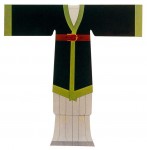 realized that although the Zhao army had better weapons, the long robes worn by generals and warriors were too cumbersome for an army, especially when they had to drag their armors and supplies around. They had tens of thousands of soldiers, but few riders flexible to make a quick attack. He went against all objections and advocated for change towards the Hu or western minority clothing style of the nomadic riders. The Zhao soldiers wore shorter robes and trousers and soon became a better army. Economic development followed.
realized that although the Zhao army had better weapons, the long robes worn by generals and warriors were too cumbersome for an army, especially when they had to drag their armors and supplies around. They had tens of thousands of soldiers, but few riders flexible to make a quick attack. He went against all objections and advocated for change towards the Hu or western minority clothing style of the nomadic riders. The Zhao soldiers wore shorter robes and trousers and soon became a better army. Economic development followed.
Moreover, this style that was once frowned upon and rejected became the daily wear of the common folks by Wei, Jin and Southern and Western Dynasties in the central plains. One reason for this change, unfortunately, was the frequent migration of the people to run away from the incessant wars and chaos. This process also helped the exchange of garment culture. Kuzhe and liangdang are the typical “Hu” or minority wear of that time. It is not hard to see that both styles are fit for riding and for life in the cold climate. The so-called kuzhe is a style with separate upper and lower garments. The upper garment looks like a short robe with wide sleeves, a central China adaptation to the original narrow sleeves fit for riding and herding animals. What also changed was the closure of the robe, which moved from left to right. Interestingly, people of central China called the northwestern people “people with left closure.” The robes at this time were shortened significantly, and varied in style. Historical materials show a number of styles of these upper garments in Wei, Jin, Southern and Northern Dynasties, which had left, right and middle closure, or even swallowtails at the front hem. A set of these garments makes the wearer sharp and agile, as is frequently seen in clay burial figurines in the Southern Dynasty.
The lower garment of the kuzhe is a pair of trousers with closed crotch. Initially these trousers were close fitting, showing off slender legs that could freely move around. When this style appeared in central China, especially when some officials wore them in court, the conservatives questioned the appropriateness of the two thin legs that cried out rebellion against the loose fitting traditional ceremonial wear. Widening the legs was a compromise, so that the pants still appeared similar to the traditional robe. When walking about, these pants were more flexible and convenient than the robe. To avoid being caught in thorns or dragged in mud, someone came up with a brilliant idea of lifting the trouser legs and tying them up just below knee-level. This kind of pants can be frequently seen in the Southern Dynasty’s burial figurines and brick paintings. In appearance, they are quite similar to the bell bottomed pants in the modern days, but in reality, they are only similar in profile, not in construction.
Liangdang or double-layered suit is another style typical of this period, and it came from the northwest into central China. It was no more than a vest, which can be seen in many burial pieces of that time. Judging from clay figurines and wall paintings in tombs, the vest was in two separate pieces fastened on the shoulders and under the arms. There were also liangdangs worn inside in materials of leather or cotton, lined or unlined, close or loose fitting. The name has changed over the years but the style remained. The above mention garments were all the rage at that time for both women and men. The separate piece style has always been the prototype of the Chinese people, but modifications were made due to the exchange and fusion of different garment cultures.
Royal Ceremonial Wear
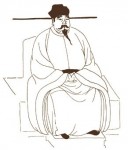 The mianfu and the dragon robe are typical garments for ancient Chinese emperors. They serve as a micro cosmos that exemplify the unique Chinese aesthetic and sense of the universe.
The mianfu and the dragon robe are typical garments for ancient Chinese emperors. They serve as a micro cosmos that exemplify the unique Chinese aesthetic and sense of the universe.
In Chinese history there is a story of “Dressed with yellow robe” that occurred in 959 A.D. One year after a young emperor took over the throne at the death of his father, the old emperor, a general was dressed with the royal yellow robe by his supporters and made emperor. That was the beginning of the Song Dynasty. But why does the “yellow robe” represent the emperor? It all started in the Han Dynasty.
The Chinese theories of the Yin and Yang and of the Five Elements all try to explain the interdependence and mutual rejection of gold, wood, water, fire and earth. White represents gold; green represents wood; black represents water; and yellow represents earth. In Zhou Dynasty, red was regarded as the superior color for garments, but by Qin Dynasty (221 B.C.-206 B.C.) black ranked highest among all garment colors. All officials followed suit and wore black as much as they could. When Han Dynasty replaced Qin, yellow was promoted to the highest place, favored by the emperors of the time. By Tang Dynasty the court made it official that no one, except the emperor, had the 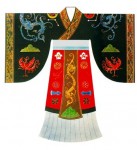 right to wear yellow. This rule was passed all the way down to the Qing Dynasty. It was said that when the 11-year old Pu Yi (1906-1967), the last emperor, saw his 8-year old cousin wearing yellow silk as his clothes lining, he grabbed the sleeve and said: “How dare you use yellow!” The status of the color yellow was apparently supreme in their heart.
right to wear yellow. This rule was passed all the way down to the Qing Dynasty. It was said that when the 11-year old Pu Yi (1906-1967), the last emperor, saw his 8-year old cousin wearing yellow silk as his clothes lining, he grabbed the sleeve and said: “How dare you use yellow!” The status of the color yellow was apparently supreme in their heart.
In ancient Chinese society, it was all strictly specified which class should wear what on what occasions. What the emperor wore on important occasions had a special name: mianfu.
Mianfu is a set of garments including the mianguan, a crown with a board that leans forward, as if the emperor is bowing to his subjects in full respect and concern. Chains of beads hang at front and back normally twelve chains each, but also in numbers of nine, seven, five or three, depending on the importance of the occasion and the difference in ranks. The jade beads are threaded with silk, ranging from nine to twelve in number. Hairpins are used to fasten the crown to the hair, and two small beads hang above the ears of the wearer, reminding him to listen with discretion. This, like the board in front of the crown, has important political significance.
The upper garment of emperors is normally black while the lower garment is normally crimson. They symbolize the order of heaven and earth and should never be confused. Dragon is the dominant pattern embroidered on the emperors clothing, although another 12 kinds of decoration can be seen as well, including symbolic animals, or natural scenes with sun and moon. These pa????erns are allowed on the lords as well, but they differ in complexity according to different ranks and importance of the occasion.
Mianfu with upper and lower garments are fastened with a belt, under which a decorative piece called bixi or knee covering hangs down. This piece of decorative cloth originated in the days when people were wearing animal skins, used primarily for covering the abdomen and the genitals. This part of clothing remained until later years, becoming an important component of the ceremonial wear. Even later, the bixi became the protector of the royal dignity. The emperor’s bixi is pure red in color.
Shoes to go with the mianfu are made of silk with double-layered wooden soles. Another kind exists that uses flax or animal skin as the sole depending on the season. By order of importance, the emperor wore red, white or black shoes on different occasions.
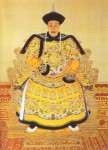 The most outstanding feature of the Chinese royal attire is the
The most outstanding feature of the Chinese royal attire is the 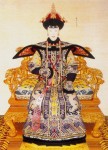 embroidered dragon. In Ming and Qing Dynasties, the robe had to have nine dragons embroidered, on front and back of the two shoulders and two sleeves, as well as inside the front lapel, displaying the royal prominence bestowed by the gods.
embroidered dragon. In Ming and Qing Dynasties, the robe had to have nine dragons embroidered, on front and back of the two shoulders and two sleeves, as well as inside the front lapel, displaying the royal prominence bestowed by the gods.